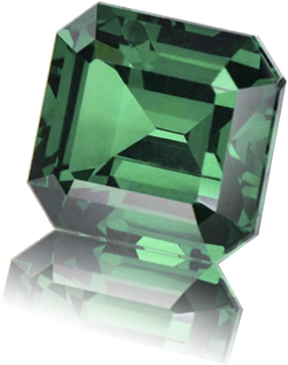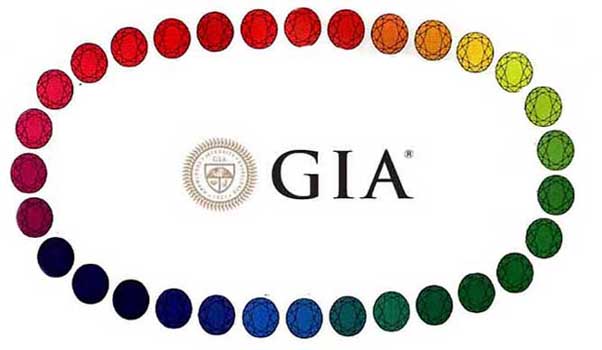

We are currently closed. We will be Re-opening Last Week of November.

Over the years, Tanzanite has been judged in many different ways. Originally, it was the miners who developed a system ranging from AAA to C to describe their production. Those were simple days when judging Tanzanite was easy and most played by the rules.
Now a quick search in the market, particularly the online market will show you AAA, AAAA and even AAAAA labels attached to stones which look paler than any self respecting miner would have graded his B or C grades. The GIA color grading system was the most widely used for years and still is in the B2B trade. Then came the Tanzanite Foundation system, the ICSL system and finally various unofficial systems which have proliferated in the age of the internet. This article will look at each in turn.

The GIA Grading System
The Gemological Institute of America is one of the world’s most respected authorities on colored gemstones and Diamonds. Its Diamond grading system is the most universally accepted and widely used worldwide.
Color Grading in this system
The system works by breaking down Tanzanite color into 3 distinct components, Hue, Tone and Saturation and then compiling a 3 part grade. The grade is scientifically based on a researched color wheel, seen further in the article and there are 3 components. Recently “hybrid” attempts at using the GIA system have appeared in the online community with only 2 of these components used - Grades such as vB 6 for example are not actually GIA grades at all as they omit the saturation grade and only mention the tone. Our article on Tanzanite Color and Value c overs the dangers of grading color on tone only.
Describing Hue
First of all the Hue of the Tanzanite is considered. This is the actual color sensation the human eye perceives when it looks at the stone. Then a grade is compiled specifying the modifying hue in a lower case letter fist followed by the dominant hue in a capital letter. The 2 hues the GIA recognize in Tanzanite are blue and violet.
Hence, if a Tanzanite is predominately blue, with the table oriented on the blue axis (Tanzanite is trichroic so the optic axis can be blue or violet – more on this in our article on Trichroism in Tanzanite, then it is described as having a dominant blue Hue with a violet modifier. It would thus carry the Hue description vB (violetish Blue). Obviously the converse is true if the dominant hue is violet – bV (bluish Violet).
The GIA also allows the grader to describe the extent to which a hue is constituted. For example, a Tanzanite may have a very slight violet modifier or a very strong violet modifier in which case it may be described as “very slightly violetish Blue” or “very strongly violetish Blue” respectively. The chart below illustrates this.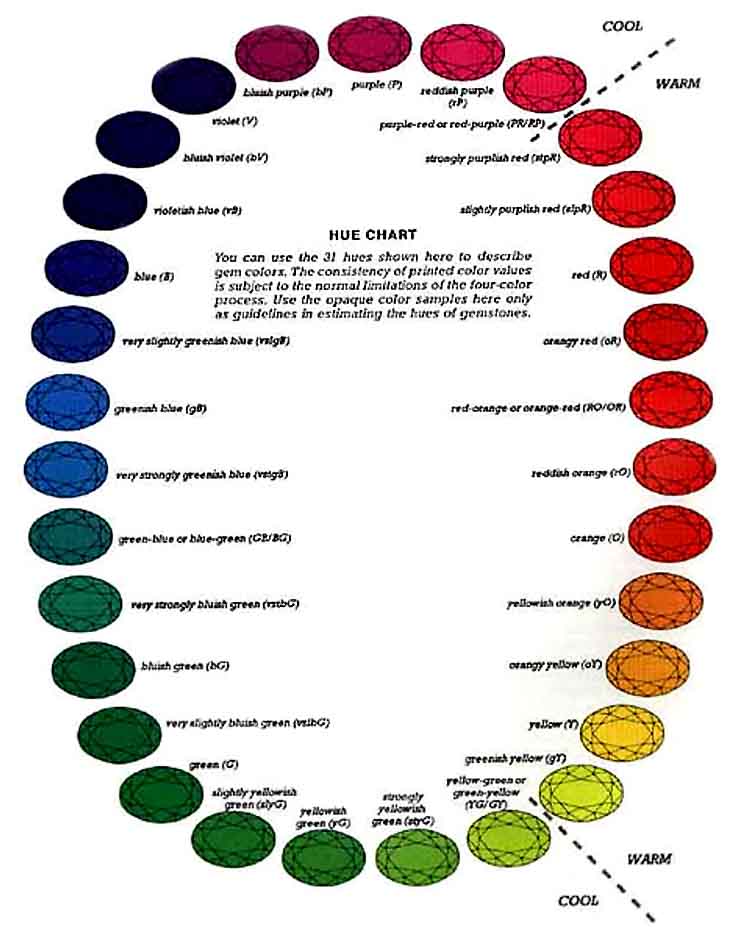
GIA Color Wheel. The GIA Hue Wheel showing how hues are denoted. Colors are not accurate.
Describing Tone
Tone is effectively the lightness to darkness of a stone. In other words it relates to the light extinction within a gemstone – dark, black areas with no real color. Badly cut gems often carry very high tone scores because they appear very blacked out as there is little internal light reflection. This can make the stone look dark and the sensation of color is limited to the blackness the eye perceives. The GIA divides tone into 11 steps from colorless or white through increasingly darker grays to black. Seven of these grades are utilized in the GIA system for grading tone in transparent colored stones. These are:
2: very light (hue)
3: light (hue)
4: medium light (hue)
5: medium (hue)
6: medium dark (hue)
7: dark (hue)
8: very dark (hue)
The optimum range for Tanzanite is 4—6 where the stone is neither too light or too dark. The very finest stones lie in the 6 range.
Describing Saturation
Saturation is arguably the most important component in the GIA color grading system. It describes the depth of color which is the most important factor of all. It is in effect the strength of the hue itself. It is assessed with a number 1 through 6. This chart shows how saturations work in the GIA system.
The highest saturation level is 6 which is described as vivid. Whilst you will see the number splashed liberally across many online sellers online portals, saturations of 6 rarely occur in Tanzanite or most gem types. Aquamarine for example doesn’t go beyond a color saturation of 5. Saturations of 6 in Tanzanite are rare and to truly award this grade in an objective manner the stone must be exceptional. The vast majority of Tanzanite mined lies in the 1-3 saturation range.
Putting it All Together
All 3 components are then combined to create the overall GIA grade for a Tanzanite as follows:
HUE – TONE – SATURATION
Hence an extremely fine Tanzanite would carry the grade vB 6/6 standing for violetish Blue Tone : 6, Saturation : 6 Very few Tanzanites mined truly deserve to be awarded this grade, despite what you would be lead to believe researching online.
The chart below tries to demonstrate how tone and saturation works in the GIA system: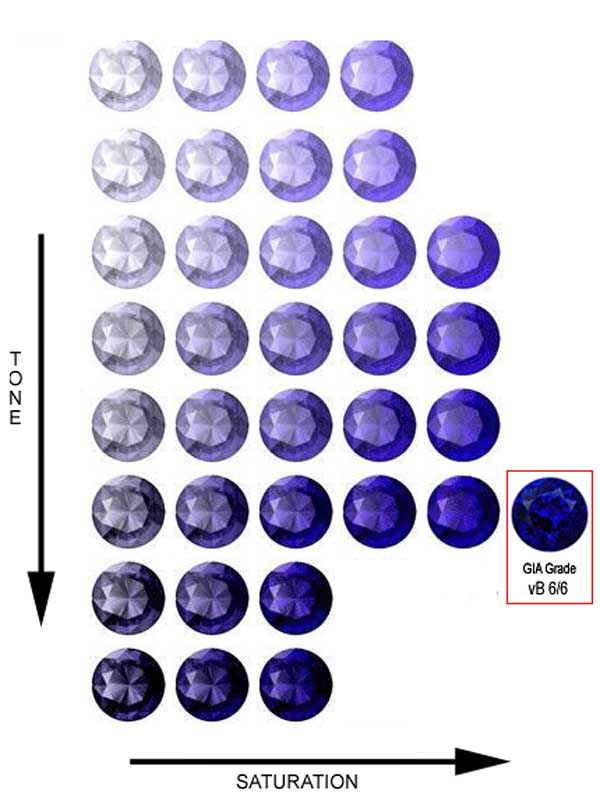
Overall, the GIA system is a very effective system at grading color unsubjectively. It approaches each of the grading components unemotionally and allows for an effective accurate grading of the gemstone.
This is the reason it is the most widely accepted system in the trade today. The Guide Gem Price Index, the largest price index for colored stones in the US market uses the GIA system as a result and as such, much of the trade understand and allude to it.
Unofficial Systems
With the rise of the internet, there have appeared a myriad
of questionable hybrid systems. I mention these in this article purely to
highlight the problem facing most internet buyers or researchers these days –
lack of clarity in comparing “like with like.” Most of the grading systems, if
they can actually be called that at all, appear to be hastily constructed
selling tools rather than grading systems. I have seen GIA grades represented
in such formats as vB6+++. It seems that adding as many plus signs as possible
to a grade gets around the subjectivity issue!
In actual fact, the way in which grading systems have been turned into a marketing tool is of great concern to the section of the trade that values objectivity and consistency in grading and representation of gemstones. If the gem trade is to continue flourishing in this age of lab created gems and treatments, natural gemstones must be represented in an ethical and objective manner to avoid consumer confidence issues.
Some of the grades we have documented online in the past year, used in various
mediums are:
AAAAA or AAAA
vB6+ or vB6+++ etc
vBe+++
SD
The fact is, none of these grades are actually part of any
recognized or documented lab grading system, neither are they used at the
mining level. They are purely marketing statements with little objectivity
behind them. Whilst we do not contend that the seller is not trying to convey
the grade accurately the very fact that they are using a system that carries no
professional backing should be of concern.

Tanzanite Foundation Grading System
The Tanzanite Foundation has developed its own
color grading system which is used mostly in its native South Africa. It has
attempted to group Tanzanite colors into a simple, consumer friendly chart
shown below. 
Whilst the chart and color denotions are a good marketing tool and have been a help to consumers undoubtedly in providing a basic understanding of color in Tanzanite, many gemologists and dealers have disputed the accuracy of the model largely because the top color grade assigned vBe, sometimes seen written as VBE, denotes a color at least 2 grades below the colors of the very finest stones seen in the market.
The color is too desaturated to compare with the finest stones. Whether this is because these colors are very rare and as such do not lend much value to their for-profit arm Tanzanite One is open to debate. Some would contend that Tanzanite One is in the business of selling Tanzanite and as the vast majority of production is in the lower grades there is nothing to be gained by developing a color system that effectively devalues the colors they mostly sell by showing a top grade they very rarely have. Hence a grading system with a top color of which they have a large quantity is more desireable.
Whatever the reason, it is not debatable that there exist better more intensely saturated colors than those depicted in their chart which leaves the credibility of the system open to individual interpretation. Similarly, the use of words such as “exceptional” can be construed to delegitimize the system as it appears more of a marketing tool rather than an objective grading system, uninterested in promoting what it is grading.
Nevertheless the system does have some value in trying to standardize Tanzanite grades and communicating to consumers how color affects value in Tanzanite. It is important to be aware of its limitations though.
The Miner's System
Long before grades of the laboratory type were even considered for colored
gemstones, the Tanzanite miners digging the beautiful blue stone from the
ground developed their own lingo to describe the many colors they were seeing
as they carefully chipped the precious mineral from their mine walls. The
system was simple and universally accepted amongst miners and the gemstone
dealers they sold to. AAA was the term reserved for the very finest pieces that
they very rarely found. Then came AA, A, B, C. These represented the various
levels of desaturation.
The ICSL System
This is a good, comprehensive system in that it attempts to
look at more components of gemstone color quality than most systems. It comes
at the problem from a different angle than other systems in that it effectively
starts with a perfect score (100) and then makes a series of deductions on a
stone to constitute the final grade. The chart below shows how this works 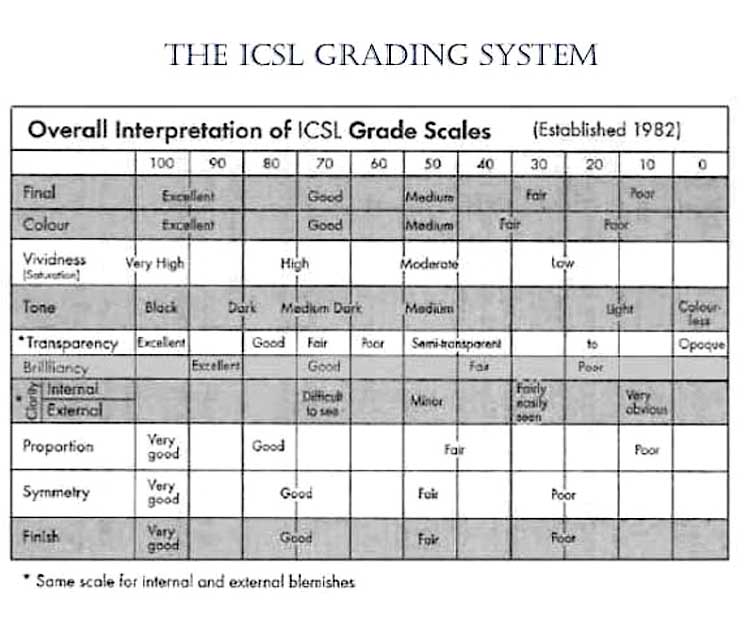
This article does a good job of explaining this system in detail : http://www.adamasgem.org/icsl.pdf
The system is not widely known or used these days although
perhaps it deserves to be. As it comes from a position of deductions many
sellers regard it negatively as they do not want any negative associations with
their merchandise, which may explain its limited uptake by the industry.
To Summarize
These are only a few of the many grades and grading systems a confused consumer may encounter when trying to research their Tanzanite purchase. The jury is still out on which system is best and certainly there is room for a better one to be developed. The only certainty is that there is very little correlation between the different systems and as such comparing “apples with apples” is very difficult. Hopefully the information in this article will go some way to making the situation more understandable.
Antony completed his GG (Graduate Gemologist) in 1998 at the Gemological Institute of America in California after a degree a Business at the University of Bath, in England. He has extensive experience in the colored gemstone trade with over 20 years buying rough at the source. He is currently the Ambassador to Kenya for the ICA (International Colored Gemstone Association) in New York which is the worldwide body for colored gemstones.
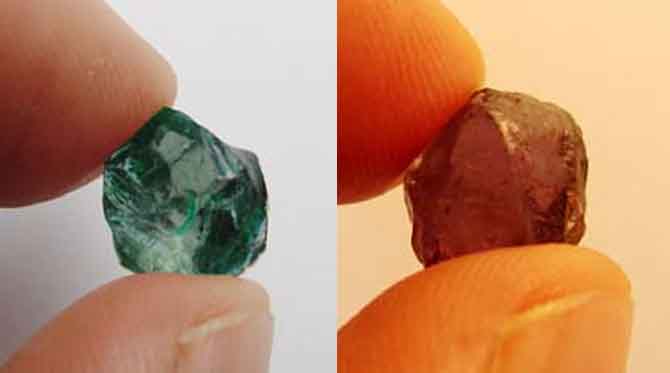
A new discovery in the renowned Taita district of Kenya has taken the gem world by storm. We take a look at the new stone and the discovery.
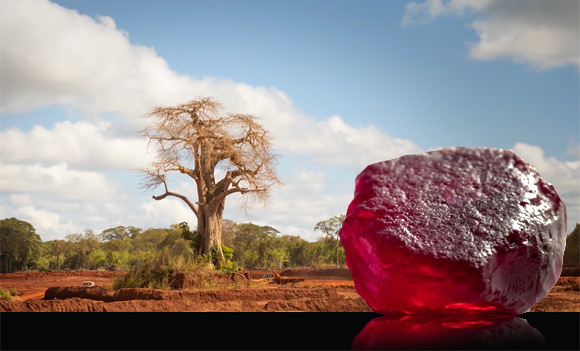
Some of the world's finest and rarest Rubies are now mined in Africa. The traditional sources in Asia have been depleted and there's a new kid on the block. This article delves into the fascinating world of African Rubies, where and how they are mined.
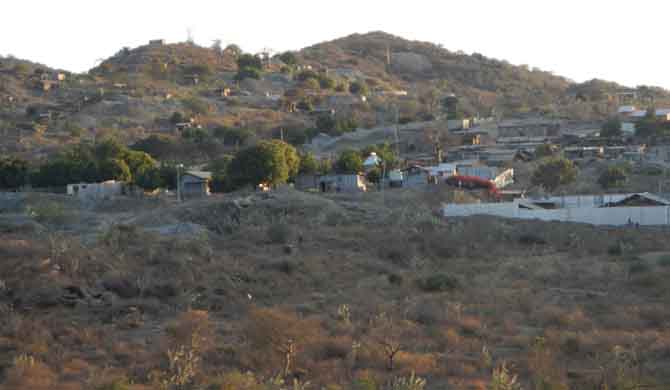
There is a great deal of misinformation currently online regarding what "ethical" Tanzanite mining is. This article explores the different opinions.
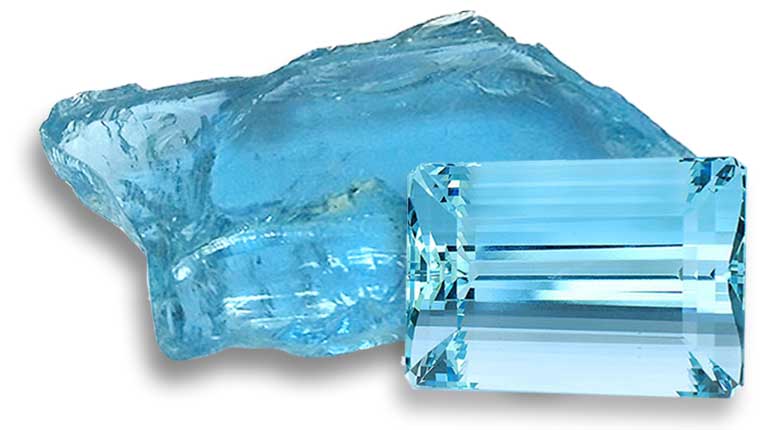
Everything you need to know about Aquamarine Gemstones. Learn all about this beautiful, rare gemstone. Learn about its properties, how to judge quality, pricing, how it is mined, where it comes from and how to spot imitations.
FEATURED IN



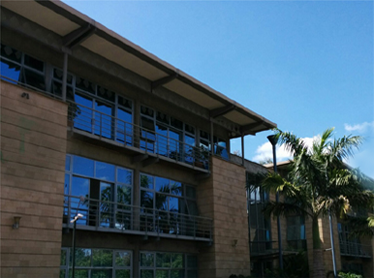

 USA : 1 888 281 3678
USA : 1 888 281 3678 Canada : 1 888 281 3678
Canada : 1 888 281 3678  United Kingdom : 0800 368 6128
United Kingdom : 0800 368 6128 Australia : 1 800 940 788
Australia : 1 800 940 788Direct : +254 20 2641700
Office Hours 9am to 5:30pm Monday to Friday

Direct your questions about shipping, returns,
payments and any other queries

If you can't find what you are looking for in our regular collections,
submit a Special Request and let us cut / source it for you. You will be
notified by email if we find a gem that matches your specs.

Your Product has been successfully added to the cart.
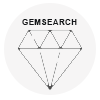
Thank You for submitting a Special Request .
We will notify you by email when we find gems that match your specifications and may interest you.
You can see and manage your special requests in your account by loggin into your account and clicking on the link Special Requests.

MESSAGE SENT
We will respond shortly
ASK A GEMOLOGIST FEATURE
Terms and Conditions of Use
Use of our acclaimed Ask a Gemologist feature which affords you access to certified GIA gemologists is free of charge. However, you agree to the following tenets when you use the Ask a Gemologist feature:
1. You will be signed up as a member of theraregemstonecompany.com with all the rights and privileges of membership.
2. Questions addressed to the Gemologist panel must be related to our business. Questions unrelated to gemstones or jewelry on our website will not be answered.

FRIEND REFERRAL ADDED SUCCESSFULLY
Our system has opened them a Member's Account and sent them
an introduction email. If they purchase off the site, 6% of the sale
will automatically be credited to you EAG Account Statement

NO ITEMS FOUND WITH THAT ID
Thanks for your email .
We will reply shortly.
